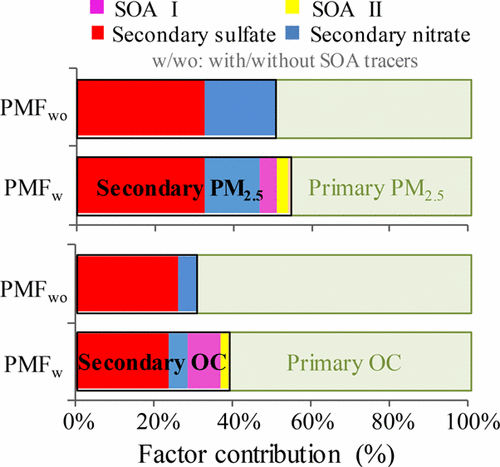当前位置:
X-MOL 学术
›
ACS Earth Space Chem.
›
论文详情
Our official English website, www.x-mol.net, welcomes your feedback! (Note: you will need to create a separate account there.)
Impact of Secondary Organic Aerosol Tracers on Tracer-Based Source Apportionment of Organic Carbon and PM2.5: A Case Study in the Pearl River Delta, China
ACS Earth and Space Chemistry ( IF 3.4 ) Pub Date : 2017-10-18 00:00:00 , DOI: 10.1021/acsearthspacechem.7b00088 Qiongqiong Wang , Xiao He , X. H. Hilda Huang , Stephen M. Griffith , Yongming Feng 1 , Ting Zhang 1 , Qingyan Zhang 1 , Dui Wu 2 , Jian Zhen Yu 1
ACS Earth and Space Chemistry ( IF 3.4 ) Pub Date : 2017-10-18 00:00:00 , DOI: 10.1021/acsearthspacechem.7b00088 Qiongqiong Wang , Xiao He , X. H. Hilda Huang , Stephen M. Griffith , Yongming Feng 1 , Ting Zhang 1 , Qingyan Zhang 1 , Dui Wu 2 , Jian Zhen Yu 1
Affiliation

|
Knowledge of the relative abundance of primary organic aerosol (POA) and secondary organic aerosol (SOA) forms an important scientific basis for formulating particulate matter (PM) control policies. Taking advantage of a comprehensive chemical composition data set of PM2.5 including both POA and SOA tracers (most notably, SOA tracers of a few biogenic voltaic organic compound precursors), we investigate the impact of inclusion of SOA tracers on the source apportionment of organic carbon (OC) and PM2.5 in the Pearl River Delta region of China using positive matrix factorization (PMF). In PMF runs incorporating SOA tracers (PMFw), ten PMF factors were resolved including four secondary factors: (1) SOA I (α-pinene, β-caryophyllene, and naphthalene-derived SOA), (2) SOA II (isoprene-derived SOA), (3) a secondary sulfate factor, and (4) a secondary nitrate factor. In PMF tests without SOA tracers (PMFwo), the SOA I and SOA II factors could not be extracted, but the remaining eight source factors were resolved. Among the eight common source factors, the industrial emission factor, identified by high loadings of Zn and Pb, showed the largest variations between PMFw and PMFwo solutions. The source contributions of SOA I and SOA II resolved in PMFw were largely shifted to the industry emission source in PMFwo. Secondary organic carbon (SOC) summed from the four secondary factors in PMFw contributed ∼40% (4.47 μgC/m3), and the SOC estimate by PMFwo (3.51 μgC/m3) was 21% lower due to the inability to extract SOA I and SOA II. Secondary PM2.5 by PMFwo was 6% lower than that by PMFw (23.7 vs 25.2 μg/m3). The PMFw results indicated that SOC from specific precursors may have different formation pathways than secondary sulfate and nitrate formation processes, and their source contributions could not be properly resolved without the indicative tracers included in PMF. This study demonstrates the utility of biogenic SOA tracers in resolving isoprene-derived SOA and highlights the need for more SOA tracers, especially those specific to anthropogenic precursors, in improving the source apportionment for those broad OA sources such as industrial emissions.
更新日期:2017-10-19


























 京公网安备 11010802027423号
京公网安备 11010802027423号